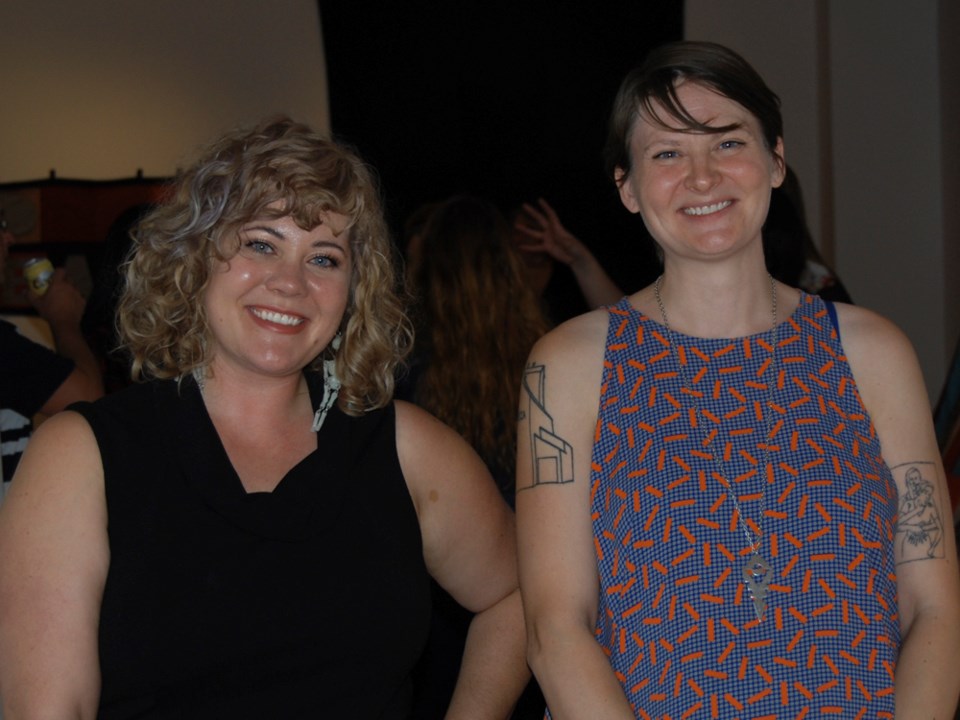At Friday’s exhibition at the Estevan Art Gallery and Museum, artists explored some of the darker recesses of the human mind. Brette Gabel’s Daymares and Zoë Scheider’s Close Encounters combined elements of horror and the paranormal, with the mundane and domestic, in a series of projects that took a sometimes whimsical take on the things that go bump in the night in the human psyche.
Guests came from all across Saskatchewan to the gallery to partake in the viewing, during which the artists spoke of what specifically motivated them to create the works they put on display.
“My work is a collection of things I’ve been mulling over. A lot of my work is situated in the space between what makes us comfortable, and what makes us really uncomfortable,” said Gabel. “It’s not supposed to be really spooky; it’s about what haunts us personally, and how it relates to cultural images or icons.”
Gabel had a series of quilts on display, imbued with a great deal of symbolic significance to her. She noted that her works focus on themes relating to what is disturbing and troubling in life, in relation to a person’s own narrative.
Many of the pieces she crafted represented personal struggles on her part. The Hag, a black quilt, was deliberately designed to be heavy and black, to the point of being physically oppressive. The weightiness of the piece was designed to evoke the experience of sleep paralysis, when someone feels awake, but is still asleep and unable to move, having a nightmare.
“Family and friends told me about a recurring nightmare they had and I was trying to interpret that through quilting,” said Gabel. “It’s a haunting experience, and it comes from a time in my life when my family was going through a lot of problems with mental illness affecting us.”
Other projects in Gabel’s exhibit included Abracadabra, a quilt originally meant as a “security blanket” that eventually became enormous, overwhelming her as she created it. That enormity, she says, factored into its creation and the feeling she was trying to evoke with it. Babalon, a complex and colorfully designed quilt, is a reference to a dualistic female deity. Gabel said Babalon represents a struggle on her part, in which she tries to reconcile between a desire to live a more carefree life and accept the oncoming responsibilities of motherhood, since she’s pregnant
Schneider’s works explored the imagery associated with folkloric creatures, and featured a similar blending between the commonplace and the supernatural.
“I’m also fascinated with UFOs, ufology and aliens. That’s what I used to examine the world of memory and perception and how we perceive our environments,” said Schneider.
A series of pictures featuring people covered by white sheets, made to look like ghosts was arranged on the wall of the gallery, entitled Ghosties. Schneider noted that the “ghosts” in otherwise normal-looking situations are meant to represent her desire to cultivate meaningful memories in life, and anxiety she felt relating to that, recreating moments that were “dead,” due to the fact that people’s memories are subjective and changing.
Subjective and changing perspectives were recurrent themes in Schneider’s work.
“I found it unnerving how our experiences could change drastically over time, and started to think about how fallible memory can be, shifting and coloured by so many experiences,” said Schneider.
An example of such subjectivity on display was Via Sasquatch, a mass of small mirror fragments arranged into the shape of a sasquatch. A uniqueness of the piece is that it has an opening in the head, where a person can put their face, reminiscent of cutout scenes found in areas frequented by tourists.
“It’s playing with the idea of the paranormal tourist trap, where they make something you can interact with at a stop where you get gas and a bag of chips,” said Schneider. “The reason I worked with reflective material is to refer to the inability we have to actually document paranormal encounters. You’re supposed to get in there and take a picture, but you’re just getting a reflection of yourself back at you.”
Schneider noted that she enjoys using paranormal creatures in her art because they reflect the values and mores of a culture, the Sasquatch being an example of a “missing link” between humans an animals to ease anxieties in reflecting on how different humans are from animals.
Both exhibits began on Sept. 11, and will be running, appropriately enough, considering their content, until Oct. 31.



